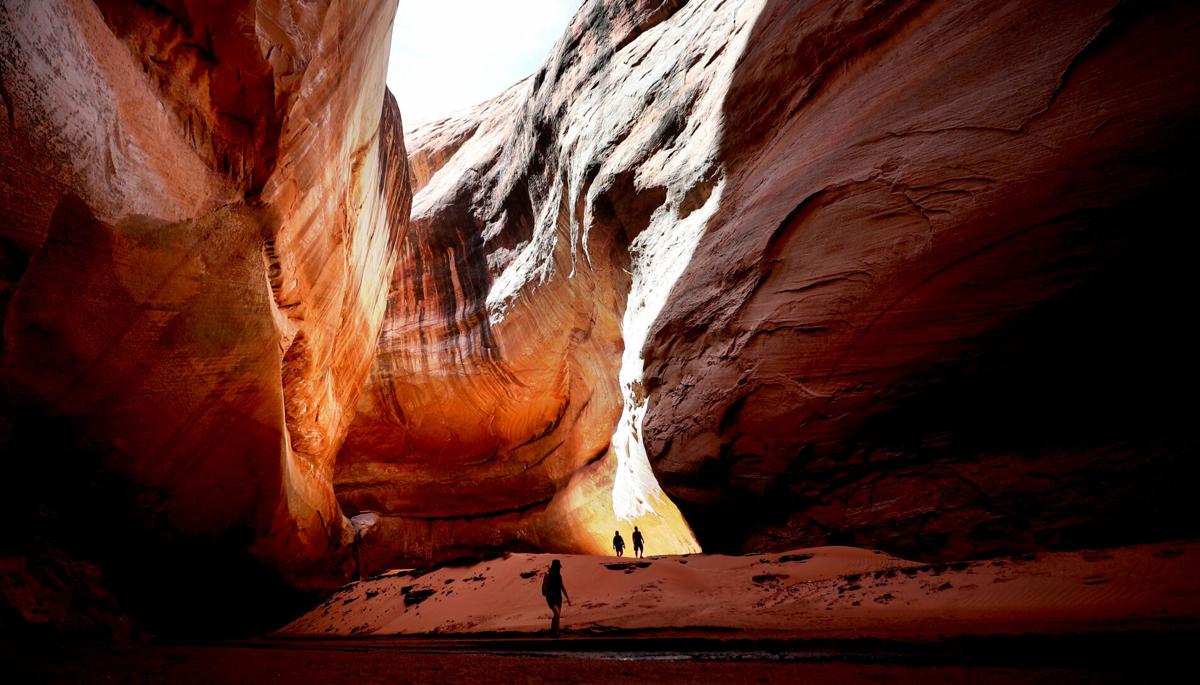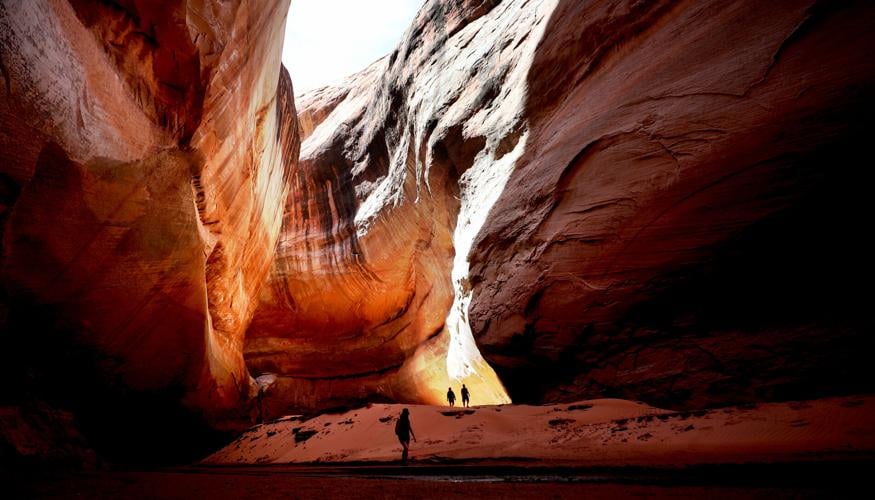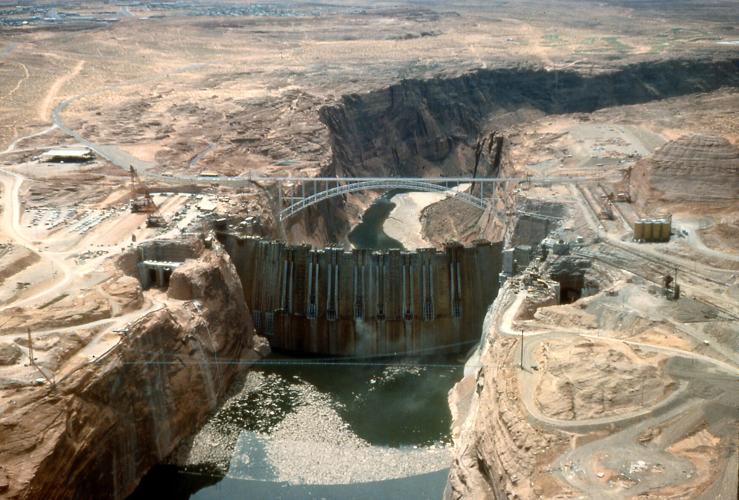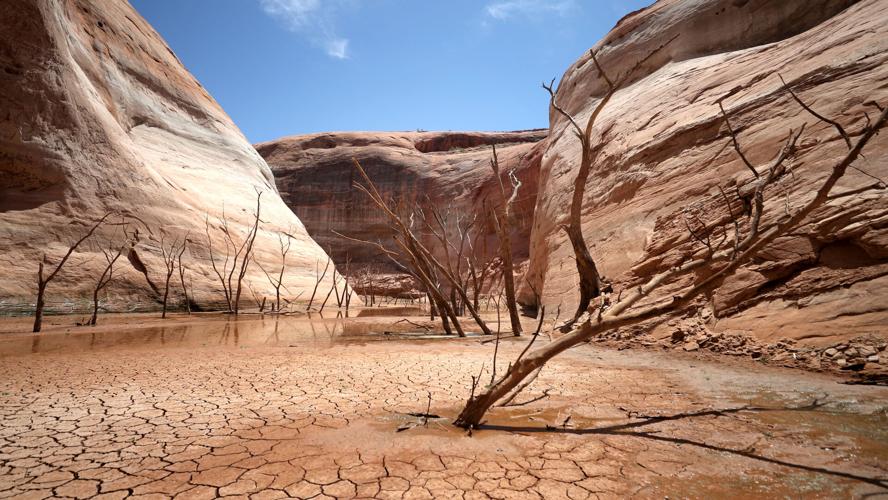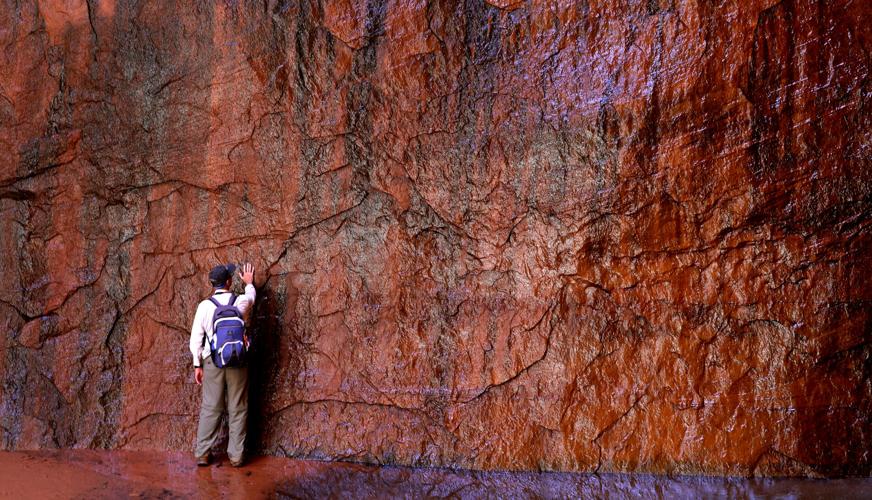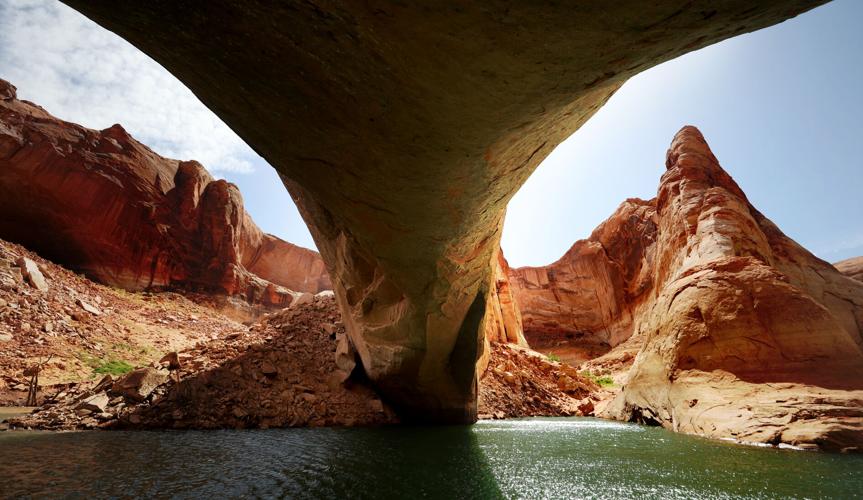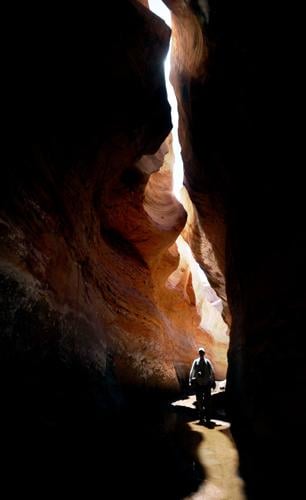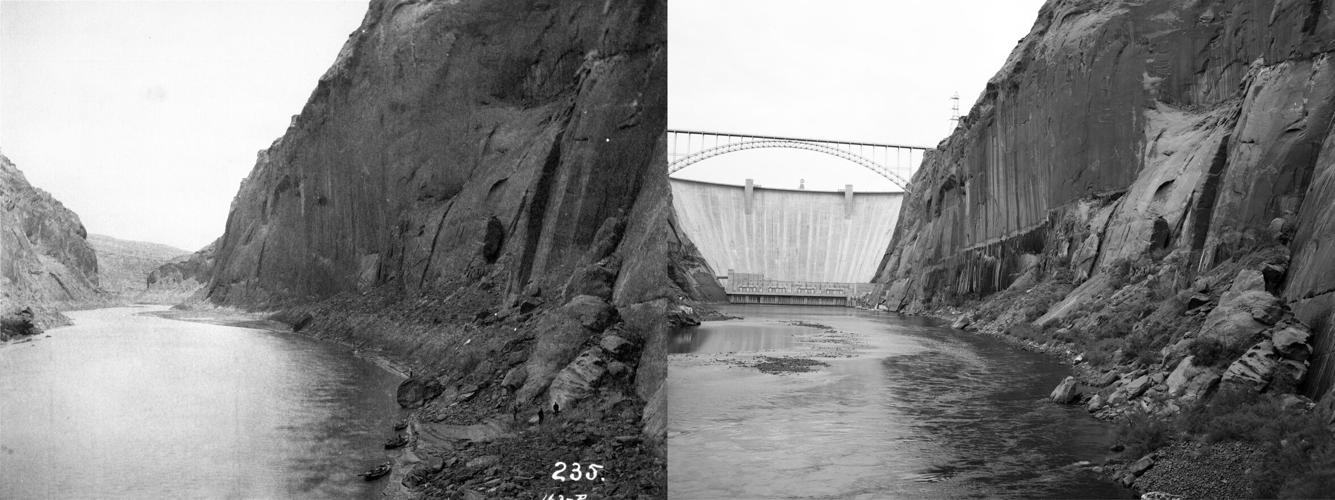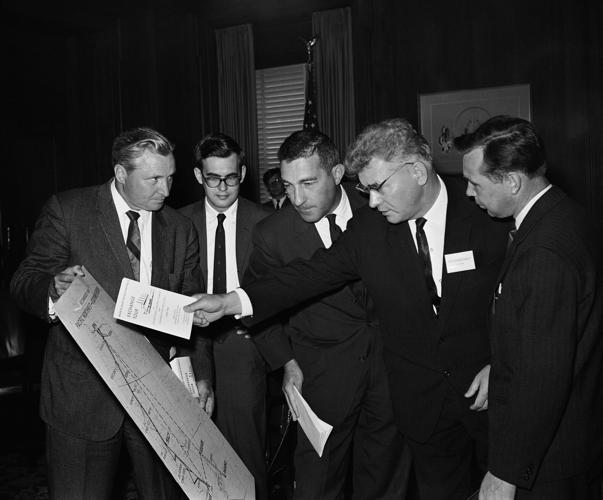Editor's note: This is the second of six stories for "Colorado River reckoning: Not enough water," an investigative series by the ├█╠ęė░Ž±AV that observes, at length, the future of the Colorado River.
It was a scene many Southwestern water experts thought they'd never see.╠²
Certainly not at Lake Powell, the nationŌĆÖs second biggest reservoir, playground for millions of boaters and fishers each year. It's a place both beloved and hated after its creation three generations ago ŌĆö by damming the Colorado River ŌĆö obliterated a transcendent natural landscape with water hundreds of feet high.
But there it was, in a small side canyon, maybe six miles upstream of the main lake ŌĆö a marvel╠²that had been underwater for most of six decades: A ribbon of water tumbled down a 75-foot-tall slickrock face in a massive grotto of red, pink and orange Navajo sandstone.
People are also reading…
It is a place aptly named Cathedral in the Desert before the U.S. built Glen Canyon Dam and flooded it out.

Sightseers explore the formation known as Cathedral in the Desert in Glen Canyon National Recreation Area, Utah. The cathedral has reemerged╠²ŌĆö╠² revealing a waterfall that's some seven stories tall ŌĆö after being submerged for decades by manmade Lake Powell.
A group of river advocates who knew of Cathedral's historic reemergence approached the grotto in May via a trickling stream, first by power boat, then on foot. It was a short walk to Cathedral from where the creek slows to a trickle and hits sand, but it seemed like a visit to a lost world.
They were joined by a group of high-school teens and college students who swam, splashed and frolicked in the greenish-hued natural pool, about waist deep, where the waterfall landed.
While sunlight barely peeped through the closed-in canyon walls, it radiated intensely off the slickrock and reflected off a bit of the pool. The sandy ground surrounding the pool rose sharply to form a bluff, maybe 15 feet high.╠²
One moss-covered wall section looked like iridescent╠²fish skin, with water seeping from the shiny slickrock. All the walls dripped with desert varnish, orange-yellow to black coating often found on exposed rock surfaces in arid environments, composed mainly of clay minerals, oxides and hydroxides of manganese and iron.╠²Cathedral lies at the end of Clear Creek, connecting to the Escalante River, which itself winds around six miles of reddish brown slickrock before connecting╠²with the main lake body on the Colorado River.
One of the river advocates, a white-haired, white-goateed 87-year-old retired electrical engineer named Frank Colver, played a haunting, improvised melody on a flute heŌĆÖd made four years ago from an elderberry tree branch heŌĆÖd gathered in Southern CaliforniaŌĆÖs San Bernardino Mountains. He wore a forest green cap that said ŌĆ£Damn DamŌĆØ and a brown Grateful Dead jacket. The younger crowd fell silent as Culver played, then applauded when he╠²finished.
Cathedral in the DesertŌĆÖs reappearance underscores a huge transformation. ItŌĆÖs one of many areas of historic Glen Canyon now returning to public view as Lake Powell keeps falling, dropping precipitously because of drought and climate change.
Cathedral and the rest of Glen Canyon had been underwater sanctuaries for most of the past 60 years ŌĆö hidden beneath╠²PowellŌĆÖs rising waters since the federal government closed the damŌĆÖs gates in 1963, creating the lake that straddles the Arizona-Utah border.
A lot of anger and angst had poured since then from environmentalists╠²in the forms of novels, polemics, songs, protests and essays over the loss of the canyon.
The flooding of its slickrock, its pinkish sandstone walls, its rounded hoodoo sculpted rock structures, the raw, reddish hues of the muddy river, its green pools, the cottonwood and willow trees, the ancient Native American petroglyphs and other ruins, and the sheer serenity of the canyon's atmosphere ŌĆö all combined to inspire a movement, first to honor Glen CanyonŌĆÖs lost world, then to fight for its restoration.
To many critics, Glen Canyon Dam was one of the U.S.'s biggest environmental mistakes of the 20th century.
In the 1960s and ŌĆś70s, nature-lovers were ignited first by Edward AbbeyŌĆÖs essay on a trip down Glen Canyon in his ŌĆ£Desert Solitaire,ŌĆØ and then by AbbeyŌĆÖs novel ŌĆ£The Monkey Wrench Gang,ŌĆØ a fanciful account of a group of eco-raiders who plotted ŌĆö but never actually tried ŌĆö to blow up the dam.

Glen Canyon Dam under construction in 1963. This view from upstream, behind the dam, reveals the eight penstocks that feed water through eight massive generators in the power plant, producing electricity for 5 million customers in the West, including some in Phoenix.╠²
In the 1980s, the radical group Earth First! dropped a 300-foot-long plastic ŌĆ£crackŌĆØ down the dam to protest its presence.
The next decade, the nonprofit Glen Canyon Institute was founded in Utah to push for draining of the lake and to ultimately ŌĆ£Fill Mead First,ŌĆØ by putting all the water stored in Lake Powell in Lake Mead, lying downstream of the Grand Canyon.
These efforts failed because they encountered more powerful economic, political and hydrologic realities. For one, Lake Powell has been a huge recreational spot of its own, drawing millions of visitors annually and thrilling boaters.
State and federal water officials paid no heed to the environmental protests and efforts, since they counted on storing water at Powell for eventual delivery downstream to Arizona, California and Nevada to meet their legal obligations under the 1922 Colorado River Compact.
Another reason is the dam generates electricity for about 5 million people living in seven states, including summertime peak load power for the Phoenix area.
But now in Glen Canyon, new cottonwood and willow shoots are sprouting. Older, dead cottonwoods are jutting 25 and 50 feet from receding waters.
Ancient rock formations long submerged now protrude 50 to 75 feet or more into the air. More waterfalls, pools and grottos like those in Cathedral are emerging. At Cathedral itself and in many other places, strips of desert varnish are slowly covering the canyon walls and beginning to replace the trademark white bathtub ring that shows how far the lakeŌĆÖs waters have dropped. Over time, the varnish will rust into a darker red as it covers the bathtub ring.╠²
ŌĆ£This is a dream come true, hiking into Cathedral in the Desert,ŌĆØ said flutist Colver, a retired electrical engineer, as he approached the waterfall and pool. ŌĆ£Woo-hoo!ŌĆØ
As water in one of the nation's largest reservoirs recedes, geologic features hidden for nearly 50 years are revealed in Glen Canyon National Recreation Area in Northern Arizona. Video courtesy of Glen Canyon Institute, 2022
But this dream wasnŌĆÖt realized by adroit lobbying, timely litigation or a change of heart among public officials. It was the product of the biggest environmental disaster in modern recorded history, one that calls into question the survival of the water delivery system on which 40 million people in the West depend.
Global warming, triggered by the burning of fossil fuels, is blamed by many scientists and a fistful of studies for up to half the decline in annual Colorado River flows of at least 20% since the start of this century.
Those declines lowered Lake PowellŌĆÖs water level by about 170 feet from July 1999 to 3,523 feet in mid-May, when an ├█╠ęė░Ž±AV reporter and photojournalist spent seven days on the lake, including accompanying Colver and his fellow river advocates on their visit to Cathedral in the Desert. Just in the past year, the lake had dropped 38 feet by the week of that visit.
While Powell rose more than 15 feet in the two months after that trip due to normal spring-summer runoff and other factors, it started declining again in mid-July and is expected to keep falling for many more months.
Conditions on the river are dire enough that, in June, the U.S. Bureau of Reclamation ordered the seven river basin states including Arizona to come up with a plan by August to reduce their use of river water by up to 28% starting next year. That didnŌĆÖt happen, and the bureau didnŌĆÖt carry out its threat to impose its own water cut plan on the states.
That left it uncertain what, if anything, will be done to reduce a water imbalance on the river between supply and demand thatŌĆÖs approaching 3 million acre-feet a year. ThatŌĆÖs about three times as much as the Central Arizona Project canal system delivers annually to cities and farms in this stateŌĆÖs parched midsection.

The tops of a grove of cottonwoods in Lake Canyon poke up through decades of accumulated silt, now drying and cracking after resurfacing due to the drastic drop in water levels of Lake Powell in Glen Canyon National Recreation Area.
At Powell itself, the water level declines have triggered a host of problems for visitors. All but two of a dozen boat ramps are totally or partially closed because the water is too low for the ramps to reach. A crucial marina about halfway up the lake has closed indefinitely. Some popular destinations on the lake are now difficult or impossible to reach, and the future of reservoir operations remains an open question.
But the question is no longer: Should Lake Powell be manually drained? If the lake keeps sinking, it could eventually drain on its own.
Nor is the question, as many Glen Canyon advocates have framed it in the past, still: Should we "Fill Mead First?" Even if all of Lake PowellŌĆÖs water were emptied into Lake Mead, Mead would be barely half full.
ItŌĆÖs now: Will the lake drain on its own, before humans can figure out how to ŌĆ£saveŌĆØ it?
And, should authorities plan for that, or should they plan and hope that the colossus that is Lake Powell, its five marinas, its thousands of houseboats, its 186 miles of waterways and its shorelines that exceed the length of the Pacific Coast, will outlast its skeptics?
Light as through stained glass
In July 1954, folksinger, Hollywood actress and Colorado River runner Katie Lee encountered Cathedral in the Desert during what was to be the first of her 16 rafting trips through Glen Canyon before Lake Powell drowned it.
A half-century later, Lee, by then an activist dedicated to getting the dam removed, described that first visit to Cathedral in her book, ŌĆ£Glen Canyon BetrayedŌĆØ:
ŌĆ£On to more stringy pools, up over boulders slick with algae, into an immense cathedral. A stone altar stands dead center under the dome ... Here the light seems to come through blue-purple-rose stained glass high above. It filters down onto the altar, on top of which lies an eroded sheaf of rocks resembling a gigantic book with its pages open!
ŌĆ£There are three of those cathedrals, each with its stone altar beneath the overhang, each with the eerie light from the nave. Our ŌĆśoohsŌĆÖ and ŌĆśahsŌĆÖ blend with the whispering water,ŌĆØ wrote Lee.
Then, in the early 1970s, after Powell had flooded Glen Canyon and its tributaries, the debate over lake and canyon flared in print, when author John McPhee took environmentalist David Brower and just-retired Bureau of Reclamation Commissioner Floyd Dominy for a boat tour of the lake for his environmental classic, ŌĆ£Encounters with the Archdruid.ŌĆØ
Brower, who had just left his job as Sierra Club director, told McPhee, ŌĆ£The magic of Glen Canyon is dead. It has been vulgarized. Putting water in the Cathedral in the Desert was like urinating in the crypt of St. PeterŌĆÖs.ŌĆØ
Dominy, the dam's biggest booster, shouted back, according to McPhee: ŌĆ£DonŌĆÖt give me the crap that youŌĆÖre the only one who understands these things. IŌĆÖm a greater conservationist than you are, by far. I do things. I make things available to man. Unregulated, the Colorado River wouldnŌĆÖt be worth a good goddam to anybody. You conservationists are phony outdoorsmen.ŌĆØ
Part of Cathedral briefly reappeared in the early to middle 2000s, when the Colorado River Basin endured a shorter and less intense drought that brought Powell down to a then-record low of about 3,555 feet in April of 2005.
Katie Lee, then 85, was boated to Cathedral by an NPR reporter that spring. ŌĆ£And I hear the waterfall and I can remember that sound really well, 'cause it fell into this beautiful pool and the pool was only about as big as this part where we are right now. You know, just a little circular pool right here. That's all it was,ŌĆØ said Lee.╠²
Mourning what was still lost, though, Lee added, ŌĆ£The canyon wrens are gone because there's no trees here, but you would hear the canyon wrens, and they were the Glen Canyons, and you'd hear the trees rustling a little bit with the breeze blowing by. So there's a lot missing.ŌĆØ
Huge snows fell that year, boosting the reservoir by 50 feet. Cathedral and other remnants of the pre-dam Glen Canyon were inundated again.

Tom Wright, an archaeologist and Glen Canyon Institute member, feels the water oozing from the rocks in the formation known as Cathedral in the Desert.╠²
'Close to a religious experience'
Colver, of Newport Beach, California, and three others who belong to the Glen Canyon Institute led the Star to Cathedral and several other once-vanished canyon landmarks in May via pontoon boat. The Salt Lake City-based group has fought for 25 years to see the dam decommissioned and the river run free and wild again.
Their boat left from Bullfrog Marina, a once-vibrant boat departure spot that was close to empty that day due to the record low water levels.
As he sat in the boat waiting to take off, Colver spoke of his first trip to Glen Canyon in 2011. It was an extraordinarily wet year, in which Powell jumped another 50 feet to 3,660 feet by mid-summer after having fallen considerably since 2005.
ŌĆ£There were no birds, no flies. All the vegetation was dead. It was a dead world,ŌĆØ Colver recalled.
But Colver was able to see increasingly large sections of Cathedral in separate trips in 2014, 2019 and 2021. Each time, the waters of Clear Creek leading to the canyon dropped a little lower, forcing him to walk a little farther: 50 feet in 2014, a quarter-mile this year. CathedralŌĆÖs visible waterfall also kept growing, from about 25 feet eight years ago, to virtually the entire, pre-dam elevation of at least 75 feet this time.
As Colver and his colleagues walked up Clear Creek, CathedralŌĆÖs walls were so narrow that one could barely see an opening in the sky. Dead cottonwoods were poking out of the stream leading to it. The canyon walls along the creek bled many colors ŌĆö orange-red of the native sandstone, deep brown, white and green where algae had grown.
Institute member Tom Wright of Tempe, a professional archaeologist, was the first member of the Glen Canyon Institute group to arrive at Cathedral on this trip. Hearing the partiers park their boat behind him, Wright rushed toward the grotto, then stopped just before reaching it, to say a short, silent prayer of gratitude, he said later.╠²
The 67-year-old Wright said he had figured he had a one in a lifetime chance of seeing Cathedral, but he now hopes this was the first of many trips there.
ŌĆ£It was not only something close to a religious experience for myself," he said, "it was like wow, the impossible has become possible.ŌĆØ
Affection for lake and canyon
As the teens and students entered the grotto, several took turns swinging on a rope across the pool that someone had previously, somehow, attached to a canyon wall. A member of the institute eventually cut the rope so people couldnŌĆÖt swing on it anymore.╠²
One participant on the trip, 22-year-old Zack Douglas of Bozeman, Montana, pronounced the scene at Cathedral ŌĆ£so cool,ŌĆØ but said that after making a handful of trips to Lake Powell, ŌĆ£every time it makes me want to move here. I hope it doesnŌĆÖt drain. I hope it fills back up completely.
ŌĆ£Maybe it was a mistake to build it but itŌĆÖs not right to take it down. Maybe they should only fill it 30 feet,ŌĆØ said Douglas.
Watching them cavort in CathedralŌĆÖs pool were Susan and Reid Leland, an Ogden, Utah, couple whoŌĆÖd brought their three children, ages 18 to 22, so they could all see the lake ŌĆ£before it dries up,ŌĆØ Susan Leland said.
ŌĆ£We do love the lake. I understand it would be better if it were a canyon in its natural state. But even if itŌĆÖs going down it still has value," she said.
The Lelands had, with another family, paid close to $8,000 to rent a 75-foot-long houseboat for a weekŌĆÖs trip through the lake. Two days earlier, however, a massive windstorm with gusts blowing at 100 mph had torn off the boatŌĆÖs roof, and they were now touring by ski boat.╠²
"If the lake were gone, I would miss it," Reid Leland agreed. "It offers so much enjoyment." Having been to the lake many times and read up on the water issue, he sees the lakeŌĆÖs problems.
ŌĆ£They created a huge reservoir of water. It was like a bank. We created a huge savings account full of water. With more population, we made more withdrawals than deposits. It feels like we are on the verge of collapse,ŌĆØ he said. ŌĆ£The question is, how is it sustainable?"
He said he understands why many think the dam shouldn't have been built, but he also thinks it would be wrong to let the lake drain.
"Two mistakes donŌĆÖt make a right," he said. "ItŌĆÖs a question thereŌĆÖs no right or wrong answer to.ŌĆØ

Dark streaks of "desert varnish" above Fiftymile Creek, a result of seepage of oxidation in the rocks, is beginning to erase the bathtub ring╠²ŌĆö the lighter colored marks left by receding waters of Lake Powell.
Ironic recovery due to climate change╠²╠²
Wade Quilter, 25, who guided the instituteŌĆÖs pontoon boat up the Escalante River toward Clear Creek,╠²recalled that his parents had taken his family to Powell every year from the time he was a toddler until he was a high school senior. He got a glimpse of Cathedral back in the mid-2000s when he was 8, seeing 3 feet of the waterfall with the lake rising to the waterfallŌĆÖs lip.
His parents brought him to Powell to ride in ski boats but he eventually transitioned to rock climbing and dirt biking. By 2015, Quilter was leading rafting trips down Cataract Canyon, which collides with Powell well upstream of Bullfrog Marina.
Now, heading into his senior year of college and preparing to apply to medical school, Quilter said he wants to spend more time seeing Glen Canyon come back, and to bring high schoolers there. He wrote a college research paper on Glen Canyon based in part on research done by the institute, and joined the group this year.
ŌĆ£This lake is dropping so fast. I want to be part of it. I want to see this actually happen, to come out here and run trips.
ŌĆ£This canyon is healthier without a lake in it. A river is supposed to flow. ItŌĆÖs not supposed to be stagnant. We are going to have to learn to manage the water better," Quilter said.
That Glen Canyon is recovering due to climate change he sees as an irony and a silver lining to the climate crisis thatŌĆÖs bringing droughts, flooding, extreme heat waves and worsening wildfires across the globe.
ŌĆ£Recovery can serve as a wake up call to deal with climate change," he said.
While itŌĆÖs easy to get ŌĆ£down and outŌĆØ about climate-related problems, focusing on things like Glen CanyonŌĆÖs recovery can also trigger positive environmental change, Quilter said.
ŌĆ£The negative makes us feel hopeless. The more we can get people to love nature, the better off society will be, in the sense of working toward ways to fix our climate problem."

The underside of Gregory Natural Bridge, passable for the first time in almost 50 years, spans Fiftymile Creek, Lake Powell, Glen Canyon National Recreation Area.
Seeing another Glen Canyon icon
From Cathedral, Quilter guided the boat back to Escalante River, then farther upstream to Fiftymile Canyon and a view of another Glen Canyon icon: the Gregory Natural Bridge. Its sandstone span dominates the surrounding landscape, forming an arch that curves over the canyon.
More spectacular red rock foundations surround the bridge, including a spire topped by a sharply formed peak.
The bridge spans about 175 feet from side to side, while the arch rises about 25 to 30 feet above the water. ThatŌĆÖs well below the 75-foot elevation that pioneering Colorado River guide Norm Nevills saw at the bridge when he first spotted it in 1940.
Nevills, the first commercial Colorado River guide, popularized the natural bridge, leading boating and hiking tours there. But it never really became popular until the gates closed on the dam in 1963. Then, visitors flocked to see it before the rising waters overwhelmed it.
ŌĆ£A striped patina of desert varnish graced the massive structure. Cottonwoods formed a trembling border of green. Natural bridges are themselves uncommon, even in the Colorado Plateau, but beautiful Gregory, considering the arid setting, was a rarity: the rock canopy spanned a perennial streamflow,ŌĆØ wrote author Jared Farmer in a 1995╠²article for the Utah Historical Quarterly.
Rich Ingebretsen, the Glen Canyon InstituteŌĆÖs founder, joined the May camping trip on its second day. As the group walked toward the bridge down Fiftymile Canyon, he recalled Gregory was the ŌĆ£showpieceŌĆØ for the legendary river guide Nevills, who led rafting trips down Glen and Grand Canyons in the ŌĆś30s and ŌĆś40s, including one featuring future Arizona Sen. Barry Goldwater.
ŌĆ£Norm Nevills would have people hike to Gregory Bridge. He made them think it was better than to hike to Rainbow Bridge" (the╠²famed╠²Rainbow Bridge National Monument, on PowellŌĆÖs southern shore). "He had flights go to Gregory Bridge,ŌĆØ Ingebretsen said.
Before it was submerged, the top of the bridge span was about 200 feet high. The bridge was completely covered by the reservoir in 1969 and remained out of view until sometime in 2021, when Powell descended into record low water level territory.
ŌĆ£A lot of the arch is still under water,ŌĆØ Colver said. ŌĆ£We donŌĆÖt know how much silt has built up since it was flooded. Who knows how long it will be before the whole opening will be visible?ŌĆØ
Just east of the bridge, the instituteŌĆÖs boat stopped at the foot of an alcove, at least 100 feet above the water level. You had to trudge up a sandy hillside to reach it; Colver recalled boating right up to it back in 2004.
As the group prepared to depart the alcove, someone spotted two desert bighorn sheep gracing a red-topped ridgeline standing a ways east of the Gregory bridge. By then, evening was approaching, and a full moon in the east sky formed a backdrop.
ŌĆ£ThatŌĆÖs a good omen. ItŌĆÖs a good place to be. You can get spiritual with it ŌĆö a place where nature and spirituality connect,ŌĆØ Wade Quilter said. ŌĆ£Moments like this show whatŌĆÖs going on ŌĆö thereŌĆÖs a whole lot more than us.ŌĆØ
Anger over 'stupid' dam
The Subway, a 90-minute, tunnel-like experience on foot, lies a couple miles and a different geologic universe upstream of Gregory Natural Bridge along Fiftymile Canyon. The walls of Fiftymile Canyon tower several hundred feet high and at their closest meet a few feet apart.
Down below, you walk along a creek bed that frequently and abruptly widens and narrows. Sometimes the canyon is wall-to-wall water, forcing you to get your feet wet and at times your pants, too. Desert willows, baby cottonwood shoots and green thistles line the banks.
As Glen Canyon Institute founder Ingebretsen navigated the Subway, he spared no invective in his attacks on the dam and reservoir heŌĆÖs fought to drain for 26 years.
Now 69, heŌĆÖs an emergency room physician in the Salt Lake City area, and doubles as an adjunct lecturer for the University of UtahŌĆÖs Department of International╠²Medicine and at several other universities.

Environmental advocate Tom Wright walks through the shaft of light peeking through the narrow openings of the formation called the Subway, accessible since the waters of Lake Powell have fallen dramatically at Fiftymile Creek in Glen Canyon National Recreation Area.
Ingebretsen recalled first seeing Glen Canyon in the early 1960s as a child, on a Boy Scout trip. The lake was being filled, but remained very low, and he could see that the damŌĆÖs top parts were still being finished.
There, he hiked up the since-inundated Forbidding Canyon, and slid down some pools in neighboring Bridge Canyon after seeing Rainbow Bridge there. He recalled walking up a trail through a tall, narrow canyon, with ŌĆ£skeeters and tadpolesŌĆØ flying around little pools.
As they walked, a guide told them, ŌĆ£Enjoy it. ItŌĆÖs going to be underwater in a year,ŌĆØ Ingebretsen said.
After the hike, the scouts crossed the river to an alcove, across from Forbidding Canyon where they ate and watched birds flying around.
"The guide, again, told us that this would be under water, and no one would ever see it again. It made me sad. It was pretty and I did not understand why they would cover it up.ŌĆØ
As a teenager in the early ŌĆś70s, Ingebretsen went back to some of the same spots with a high school group in a boat, from which he saw water covering the trail that he had hiked a decade earlier. Again, hurt and anger overcame him.
ŌĆ£It took millions of years to create Glen Canyon. That dam destroyed it in 20 years,ŌĆØ Ingebretsen said.
He feels the biggest reason for the damŌĆÖs presence is that the Upper Colorado River Basin states of Colorado, New Mexico, Utah and Wyoming wanted the project to keep some of the riverŌĆÖs water for themselves. The dam was targeted for a remote corner of Utah and Arizona, too far from most of the basinŌĆÖs farms and cities to make direct use of the water.
As Ingebretsen saw it, Glen Canyon Dam was and is a vehicle for holding back some of the riverŌĆÖs annual flow so it didnŌĆÖt all go to Lake Mead where the Lower Basin states of Arizona, California and Nevada could get it.
ŌĆ£ItŌĆÖs so the Lower Basin doesn't get more than its required share of the water,ŌĆØ he said. ŌĆ£The Upper Basin was afraid that if the Lower Basin gets more than their share, the Upper Basin wonŌĆÖt get it back."
The dam was put as close to the boundary between the two basins, which is at Lee's Ferry, 16 miles west of Glen Canyon Dam, as it could be, he said.╠²╠²
ŌĆ£ItŌĆÖs a philosophical dam ŌĆö a political dam,ŌĆØ Ingebretsen said. ŌĆ£ItŌĆÖs stupid.ŌĆØ

The Glen Canyon Dam site as it looked in 1889 and then in 1992.
Dam built to keep some water from California
To that point, historians, books about the dam and congressional testimony offer two schools of thought.
The first backs up IngebretsenŌĆÖs argument ŌĆö that the dam was built to keep all of the riverŌĆÖs water from flowing to the Lower Basin, particularly California, which was viewed by Upper Basin leaders as a voracious, water-sucking monster whose officials coveted the river for its own population growth.
The second viewpoint contradicts Ingebretsen, arguing that a real need existed for the dam to store enough water to insure there was enough to meet the 1922 Colorado River CompactŌĆÖs requirement that the Upper Basin send 75 million acre-feet to the Lower Basin states every decade.
The idea was that the dam would store enough water to have plenty available in dry years when there otherwise wouldnŌĆÖt be enough.
The damŌĆÖs construction was authorized by Congress in April 1956, as part of a much larger approval for the Colorado River Storage Project, which included 11 dams and other water projects total, spread across all four Upper Basin states. The Glen Canyon Dam was considered the cornerstone, its 26 million acre-foot capacity giving it about half the water storage space offered by the entire project.
In 2008, Utah State University historian Stephen Spurgeon chronicled the many arguments advanced for the project in an essay titled, ŌĆ£Just Add Water: Reclamation Projects and Development Fantasies in the Upper Basin of the Colorado River.ŌĆØ He painted the region as having an inflated sense of the Colorado River Storage ProjectŌĆÖs value, far beyond the main reason linked to most reclamation projects in the past: promotion of irrigated agriculture.
The projectŌĆÖs earliest stated goals were to build dams to generate enough electricity to be sold for cash to pay for additional irrigation projects, he wrote. But the Bureau of Reclamation and its boosters actually had a much larger agenda in mind: "to transform the Upper Basin of the Colorado River from a desert wasteland into a new industrial and recreational center for the United States,ŌĆØ Sturgeon wrote.
The mining of what were believed to be vast, untapped resources topped the list of potential benefits.
Pamphlets featuring maps described the region as the ŌĆ£treasure chest of the nation.ŌĆØ
Minerals reputed to exist there included lead, copper, iron, zinc, phosphates, gold, silver, oil, natural gas, gilsonite, gypsum, tungsten, molybdenum, and vanadium, Sturgeon wrote.
He continued, ŌĆ£Promoters were quick to emphasize that the Upper Basin was the chief domestic source for such strategic minerals as uranium, and contained the worldŌĆÖs largest reserves of oil shale. All that was needed to unleash these potential riches was power and water.ŌĆØ
But those and many other examples of boosterism aside, the overwhelming motivation driving the push for Glen Canyon Dam and the rest of the storage project was fear and suspicion of California, Sturgeon told the Star.
Legally, both basins, Upper and Lower,╠²have rights to the same amount of water under the 1922 Colorado River Compact ŌĆö 7.5 million acre-feet per basin. But led by Hoover Dam, most water developments since 1922 had landed in the Lower Basin, largely due to CaliforniaŌĆÖs political power, he said.
Due to the Upper BasinŌĆÖs low, rural population, water development there languished. The actual Upper Basin watershed consists mostly of rural areas and small cities and towns, with its bigger cities being Denver, Salt Lake City and Albuquerque.
ŌĆ£In water law there is a ŌĆśuse it or lose itŌĆÖ provision when it comes to water rights. Over time the Upper Basin became nervous that if they did not do something to capture and retain their portion of the Colorado River, then California would eventually establish a de facto right to the water,ŌĆØ Sturgeon wrote in an email to the Star.
ŌĆ£Did politicians believe in all the booster literature that talked about visions of massive industrial development in the Upper Basin that would benefit from the water that the (river storage project) would capture? My guess is that they did believe it to at least some extent, but it would probably be more accurate to say that they couldn't envision a future for the region without access to Colorado River water, that California represented a threat to that water, and therefore they needed to take steps to eliminate that threat.
ŌĆ£In other words, the first priority was controlling the water. Once that was done, then development could proceed,ŌĆØ wrote Sturgeon.

Interior Secretary Stewart Udall, right, with First Lady Ladybird Johnson during the official dedication of Glen Canyon Dam near Page, Arizona, on Sept. 22, 1966. The Glen Canyon Bridge is in the background.
Construction 'inevitable'
Author and retired water manager Eric Kuhn has a different take.
In 2019, Kuhn and University of New Mexico water researcher John Fleck co-authored a book outlining how the riverŌĆÖs dams and other water projects had been developed despite century-old warnings from scientists that the river doesnŌĆÖt contain nearly the amount of water allocated to the basins by the 1922 compact.
For their book, ŌĆ£Science Be Damned,ŌĆØ they extensively researched the history of how federal officials and Upper Basin water leaders developed a rationale for building Glen Canyon Dam and the rest of the storage project.
Through the 1930s and early 1940s, Reclamation prepared a detailed report, outlining the type of water developments that would be needed for the Upper Basin to have adequate water storage for its own use, and to be sure of satisfying the bureau's 1922 compact obligations for water deliveries.
ŌĆ£The bureau had many meetings with the states while they prepared this report. With the success of Hoover, there was a lot of support within the bureau, the Interior Department, and all of the states, with the possible exception of California, for another big dam and Glen Canyon was the obvious choice,ŌĆØ Kuhn told the Star.
ŌĆ£When the different state and bureau hydrologists did their studies, they came up with similar answers. The Upper Basin needed about 30 million acre-feet of storage upstream of Lee Ferry to meet their compact commitments,ŌĆØ said Kuhn, former general manager of the Colorado River Water Conservation District in Glenwood Springs, Colo.
Besides the water storage, the Upper Basin needed electricity from the turbines of Glen Canyon Dam and the other project dams to subsidize farms that would benefit from the irrigation works generated by the Colorado River Storage Project, Kuhn and Fleck wrote in their book.
ŌĆ£Glen Canyon Dam was the linchpin,ŌĆØ Kuhn and Fleck added. ŌĆ£Its storage capacity would provide most of the holdover storage, and its hydroelectric power would provide the subsidies.ŌĆØ╠²
Kuhn acknowledged that the idea of ŌĆ£'keeping California and Arizona from taking all our water' made great politics in the Upper Basin, and today it still does.ŌĆØ
But while politics provided the emotional argument for the dam, ŌĆ£I believe that even without the politics, the 1922 Compact provision requiring the Upper Basin to not deplete flows below 75 million acre-feet every 10 years made the authorization and construction of Glen Canyon Dam inevitable,ŌĆØ Kuhn said.
Broad congressional support
Testimony from a 1955 Senate subcommittee hearing on the Colorado River Storage Project showed both sides of the case.
Upper Basin senators expressed deeply felt fears that if the dam and other Upper Basin projects werenŌĆÖt built, all the river water, including their share, would keep flowing into the Lower Basin. Then, the water would be either sucked up by the much more rapid development in Lower Basin states, or be ŌĆ£wastedŌĆØ ŌĆö running unused through then-lush, now mostly parched Colorado River Delta into the Gulf of California.
At the same time, many California officials were concerned that if the Upper Basin projects were built, they eventually would use enough water that there wouldnŌĆÖt be enough left for Lower Basin states to grab their entire share, or that California would lose access to extra water it was using beyond its legally guaranteed supply.╠²
Because California had first crack╠²on development of the river with completion of Hoover and Parker dams in the Lower Colorado River Basin, ŌĆ£they now have nearly three times as much of the Colorado waters as the Upper Basin,ŌĆØ testified Utah Sen. Wallace Bennett, a leading proponent of the dam and the entire river storage project.
Due to the riverŌĆÖs boom and bust flow cycles, Bureau of Reclamation studies showed that without enough dam space to store surplus waters in wet years, ŌĆ£only about 60% of the water allocated to the Upper Basin could be used,ŌĆØ Reclamation Commissioner Wilbur Dexheimer testified.
Bureau officials also testified that the other project dams would be able to furnish water for urban growth, for farming, particularly feed crops for cattle, and for extraction of oil, copper, uranium, phosphate, coal and other minerals.
The river storage project ultimately passed both houses of Congress by wide margins.

Secretary of the Interior Stewart Udall, third from right, and Floyd Dominy, far left, commissioner of the U.S. Bureau of Reclamation, show plans for a Western power project to others on June 2, 1964. Dominy oversaw construction of Glen Canyon Dam, and wrote later that it "has tamed the wild river ŌĆö made it a servant to manŌĆÖs will."
Environmentalists gave the dam a pass╠²
Environmentalists and other conservationists, who stopped two other dams proposed for the storage project in Dinosaur National Monument at the Utah-Colorado border, gave a free pass to Glen Canyon Dam.
That was partly because it didnŌĆÖt lie in a national park or monument, and partly because they didnŌĆÖt want to be seen as opponents of all water development.
That was an act of omission that the Sierra ClubŌĆÖs Brower would regret for the rest of his life.
He recalled decades later that he always felt he could have stopped it. But in 1956 the Sierra ClubŌĆÖs board of directors instructed him, as the clubŌĆÖs executive director, not to oppose Glen Canyon Dam because Congress had killed the other dams.
ŌĆ£Instead of flying home immediately and calling for a special meeting, I just sat in Washington and watched the mayhem proceed,ŌĆØ Brower wrote in Sierra Club magazine in 1997, three years before dying at age 88.
As the Glen Canyon InstituteŌĆÖs Ingebretsen walked down the Subway section of Glen Canyon in May, he recalled that back in 1996, heŌĆÖd asked Brower why he didnŌĆÖt fight the dam.
ŌĆ£Brower said to me he didnŌĆÖt know why he didnŌĆÖt, and that ŌĆśI will wear sackcloth and ashes for the rest of my life for not stopping that project,ŌĆÖŌĆØ said Ingebretsen. Brower used that Old Testament phrase several times in his writings and speeches ŌĆö it symbolizes mourning and repentance.
Not long after the dam was finished, Brower elaborated on his regrets in a lavishly illustrated, Sierra Club coffee table book about the canyon, titled, ŌĆ£The Place No One Knew.ŌĆØ It contained more than 70 photos of the canyon by renowned nature photographer Elliott Porter.
In the foreword, Brower wrote: "Glen Canyon died in 1963 and I was partly responsible for its needless death. So were you.
ŌĆ£Neither you nor I, nor anyone else, knew it well enough to insist that at all costs it should endure. When we began to find out it was too late.ŌĆØ
Making the wild river 'a servant to man's will'
A decade later, with a slowly filling Lake Powell drawing multitudes of houseboats, ski boats and fishers, Reclamation commissioner Dominy fought back, in a 36-page, federally financed pamphlet, ŌĆ£Lake Powell: Jewel of the Colorado.ŌĆØ
Dominy oversaw most of the damŌĆÖs construction work. After leaving the bureau in 1969, he remained a vocal advocate for big dams in general and Glen Canyon in particular for the rest of his life, and died in 2010 at age 100.
ŌĆ£Man has flung down a giant barrier in the path of the turbulent Colorado in Arizona. It has tamed the wild river ŌĆö made it a servant to manŌĆÖs will,ŌĆØ said his pamphlet, published in 1965, two years after the Sierra Club book.
Dominy repeated his humans-first theme at the bookletŌĆÖs conclusion, in pitching to build two more dams within the Grand Canyon.
He wanted them to generate electricity that would raise cash to build more canals to import more water into the Southwest deserts, to augment the soon-to-be authorized Central Arizona Project. Proposals for those dams were eventually killed, after generating massive environmental protests.
ŌĆ£There is a natural order in our universe,ŌĆØ Dominy wrote. ŌĆ£God created both Nature and Man. And Man serves God. But Nature serves Man.
ŌĆ£Man cannot improve upon Nature. But ŌĆö as he has since before dawn of history ŌĆö Man must continue to adapt Nature to his needs. Still, that process of adapting must preserve, in balance ŌĆö the whole natural heritage that is his.ŌĆØ
The booklet was replete with full-color photos of water skiers, power boaters and fishers plying their skills on the lake. Other photos showed the formerly muddy red riverŌĆÖs often raging waters now still and clear-blue, reflecting sunlightŌĆÖs glare and flanked by luscious red rock canyon walls.
ŌĆ£Once in a blue moon, we come upon almost unbelievable beauty. Such was my reaction at the first sight of Lake Powell and its setting of incomparable grandeur,ŌĆØ wrote then-Interior Secretary Stewart Udall in a forward to the pamphlet.
Udall voted to authorize the damŌĆÖs construction as an Arizona congressman and in 1963 spurned BrowerŌĆÖs 11th-hour request not to close the damŌĆÖs gates. He recanted that support after leaving office.
But in this pamphlet, he hailed President Lyndon B. Johnson and his wife Lady Bird for having ŌĆ£challenged us with an exciting new concept of conservation: creating new beauty to amplify the beauty which is our heritage, as well as creation of more places for outdoor recreation. In this magnificent lake, we have made such accomplishments.ŌĆØ
Dominy promised that once Powell and the other Colorado River Storage Project reservoirs were filled with ŌĆ£surplus watersŌĆØ from wet years, ŌĆ£users of Colorado River water will be freed from disruptive cycles of drought. The reservoirs will hold sufficient water for four years of committed needs ŌĆö regardless of inflow.
ŌĆ£When the system is complete, damaging floods ŌĆö large or small ŌĆö will be impossible,ŌĆØ Dominy added.
In a dig at critics upset at seeing Glen Canyon drowned, Dominy led his pamphlet with a poem, credited to a Gordon Michelle:
"Dear God, did you cast down
"Two hundred miles of canyon
"And mark 'For poets only?'
"Multitudes hunger
"For a lake in the sun"
Dominy also wrote:╠²
"Built of rock and cement and sweat and skill, Glen Canyon Dam stands as a monument to the talent of its builders ŌĆö and to reaffirmation of the pioneering spirit that is America. The manmade rock of the dam has become one with the living rock of the canyon,ŌĆØ he wrote.
ŌĆ£It will endure as long as time endures.ŌĆØ
Recently, the Star asked bureau spokeswoman Becki Bryant how relevant the agencyŌĆÖs officials believe DominyŌĆÖs sentiments are today.
ŌĆ£No comment,ŌĆØ Bryant replied in an email.
Behind the series: The Star's longtime environmental reporter Tony Davis shares what inspired him to write the investigative series "Colorado River reckoning: Not enough water."
Photos: The receding waters of Lake Powell, Glen Canyon National Recreation Area

Tom Wright hikes past the beached marker for Willow Canyon where it joins with the Escalante River, Glen Canyon National Recreation Area, Utah.

A big horn sheep stands with the moon as a backdrop, looking over Fiftymile Creek, Glen Canyon National Recreation Area, Utah.

Tom Wright walks through the shaft of light peeking through the narrow openings of the formation called the Subway in Fiftymile Creek, accessible since the waters of Lake Powell have fallen dramatically.

A narrow sliver of sky is visible overhead through the narrow opening of the formation called the Subway, Fiftymile Creek, accessible since the waters of Lake Powell have fallen dramatically.

The dark streaking, called Desert Varnish, is from the seepage of oxidation in the rocks, and is beginning to erase the "bathtub ring", the lighter colored marks left by the waters of Lake Powell on canyon walls, Fiftymile Creek, Glen Canyon National Recreation Area, Utah.

The remains of a small boat, underwater for years, reemerges due to receding water levels of Lake Powell in the Glen Canyon National Recreation Area, Utah.
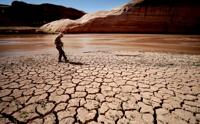
Frank Colver makes his way over the dried and cracking silt left where the Escalante River joins Lake Powell, Glen Canyon National Recreation Area, Utah. The receding water of the lake has the river cutting through the decades of accumulated silt to form a delta where it meets the lake.

A warning buoy sits high and dry far from the end of the closed public boat ramp at Bullfrog Bay, Glen Canyon National Recreation Area.

A line of tires that were once breakwaters at Bullfrog Bay Marina are now stranded on the rocky landscape high above the current water levels at the Glen Canyon National Recreation Area, Utah.

A pedestrian ramp lies well above the water levels at Bullfrog Bay in the Glen Canyon National Recreation Area, Utah.

A stranded wakeless zone buoy sits on the cracking silt outside the new shores of the Bullfrog Bay Marina, Glen Canyon National Recreation Area, Utah.

The end of the ferry ramp ends well short of the new water levels of Bullfrog Bay on the Glen Canyon National Recreation Area, Utah.

An early riser watches the sun come over the low waters of Bullfrog Bay Marina, Glen Canyon National Recreation Aria, Utah. The lighter colored areas on the canyon wall mark previous water levels.

A group of river rafters drift west on the current of the San Juan River outside Mexican Hat. The San Juan feeds Lake Powell.
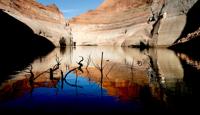
The tops of a few cottonwood trees begin to poke out of shrunken water of Lake Powell, Fiftymile Creek, Glen Canyon National Recreation Area, Utah.

The remaining large water craft and house boats are crowded together in one of the last areas of water deep enough to support them at Wahweap Mariana, Glen Canyon National Recreation Area, Page, Ariz.

The waters of Lake Powell are twenty to thirty feet below the end of the public boat ramp at Wahweap Mariana, Glen Canyon National Recreation Area, Page, Ariz. Personal non-powered craft still use the ramp to unload, but must be carried up and down the banks to reach the water.
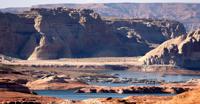
A view north from the Wahweap Marina Overlook show the shrunken waters around the marina in Glen Canyon National Recreation Area, Page, Ariz.

The underside of Gregory Natural Bridge, passable for the first time in almost 50 years, over the Fiftymile Creek, Glen Canyon National Recreation Area, Utah.

The moon rises over Gregory Natural Bridge, passable for the first time in almost 50 years, over the Fiftymile Creek, Glen Canyon National Recreation Area, Utah.

The exposed penstocks (intakes to the power turbines) on Glen Canyon Dam in the Glen Canyon National Recreation Area, Page, Ariz. The water level is at its lowest since 1967, when the dam was still being initially filled.

A group of sightseers get a look at the Glen Canyon Dam during a boat tour of Lake Powell, Glen Canyon National Recreation Area, Page, Ariz.

A small fishing boat ties up on the breakwater just outside the intakes for the Glen Canyon Dam, Glen Canyon National Recreation Area, Page, Ariz.. The penstocks (water intakes to the power turbines) are revealed for the first time since 1967 when the Lake Powell was being filled.
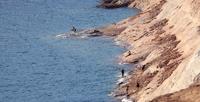
Swimmers and bathers use the jagged shores of the newly exposed banks of Lake Powell just above the Glen Canyon Dam, Glen Canyon National Recreation Area, Page, Ariz.

The Glen Canyon Bridge lies in front of electrical towers with feeder lines rising from the hydroelectric plant in the Glen Canyon Dam, Page, Ariz.

Glen Canyon Dam from Glen Canyon Bridge, Page, Ariz.
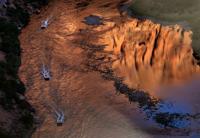
Small power boats on the Colorado River head upstream just below the Glen Canyon Dam, Page, Ariz.

Wade Quilter walks through the remains of cottonwood and Russian olive trees washed down and joined with silt to form a natural dam where Willow Canyon joins with the Escalante River, Glen Canyon National Recreation Area, Utah,

The remains of a big mouth bass lay in the silt just above where the Escalante River joins Lake Powell, Glen Canyon National Recreation Area, Utah.

The formation known as The Cathedral in the Desert on Clear Creek, Glen Canyon National Recreation Area, Utah. The re-emergence of the formation is drawing sightseers after being submerged for some 50 years.
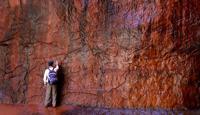
Tom Wright feels the water oozing from the rocks in the formation known as Cathedral in the Desert on Clear Creek, Glen Canyon National Recreation Area, Utah. The re-emergence of the formation is drawing sightseers after being submerged for some 50 years.

Frank Colver takes a quiet moment and plays a handmade flute near the waterfall in the formation known as Cathedral in the Desert on Clear Creek, Glen Canyon National Recreation Area, Utah. The re-emergence of the formation is drawing sightseers after being submerged for some 50 years.

Jake Quilter walks down the newly cut banks of Clear Creek just outside Cathedral in the Desert, Glen Canyon National Recreation Area Utah. The sand is silt left behind by the receding waters of Lake Powell.

The tops of cottonwood trees that used to be under a hundred feet of water in Lake Powell are visible again in Clear Creek, Glen Canyon National Recreation Area, Utah. The deep water preserved the remains of the trees.

Boaters have to zig-zag through the rocks emerging due to receding waters of Lake Powell, Glen Canyon National Recreation Area, Page, Ariz.

Several images combined for a panoramic view of the Colorado River where it runs through the what once was Hite Marina in the Glen Canyon National Recreation Area, Utah.

A couple of sightseers take in the view from Hite Overlook over the Colorado River and the closed Hite Marina, Glen Canyon National Recreation Area, Utah.
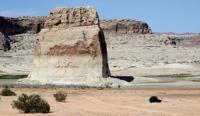
Lone Rock, jutting out of the dry bed, would usually be surrounded by Lake Powell but is now well clear of the water, Glen Canyon National Recreation Area, Utah.

Tires that used to hold the lines well below the surface of Lake Powell are suspended over the water at Antelope Point Marina, Ariz.
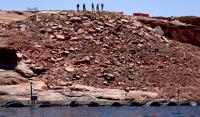
Sightseers twenty or thirty feet above get photos of the low water levels of Lake Powell from the public boat ramp at Antelope Point Marina, Ariz.

The pedestrian access ramp ends abruptly twenty feet over the new Lake Powell surface at Antelope Point Marina, Ariz.

The entrance to the pedestrian access ramp of the Antelope Point Marina is taped off after being cutoff from the docks due to receding waters of Lake Powell.
Contact Tony Davis at 520-349-0350 or tdavis@tucson.com. Follow Davis on Twitter@tonydavis987.


